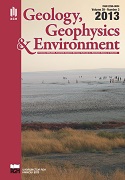AGREGATY HALITOWE WSPÓŁCZESNYCH ŚRÓDLĄDOWYCH ZBIORNIKÓW SŁONYCH – REMINISCENCJE WYPRAW NAUKOWYCH PSGS
DOI:
https://doi.org/10.7494/geol.2013.39.3.279Keywords:
halite aggregates, salt lakes, Dead Sea, Tuz LakeAbstract
W brzeżnych partiach dwóch słonych zbiorników bezodpływowych: Morza Martwego w Izraelu (wyprawa PSGS w 2006 r.) i Jeziora Tuz w Turcji (wyprawa PSGS w 2011 r.) napotkano sferyczne agregaty kryształków halitu. W Morzu Martwym „kulki” halitowe (o średnicy od kilku mm do kilku cm) zaobserwowano w strefie płytkiego przybrzeża z występowaniem wyraźnych prądów. W przypadku Jeziora Tuz kuliste agregaty halitowe (o średnicy 0,5-0,7 cm) występowały na powierzchni skorupy solnej, utworzonej w wyniku odparowania wód jeziora w okresie letnim. Formy z dna Morza Martwego to zapewne pizoidy, powstałe na bazie ooidów halitowych, wskutek agradacji kryształków solnych wytrąconych z nasyconej względem halitu solanki i przetaczanych po dnie przez przydenne prądy wyrównawcze i falowanie sztormowe. Genezę „kulek” z Jeziora Tuz należy prawdopodobnie wiązać z działalnością wiatru (halitowe „ooidy eoliczne) i są produktem transportu eolicznego agregatów i pojedynczych kryształów halitu po odsłoniętej, chropowatej powierzchni skorupy solnej. Oznaczone w kilku „kulkach” zawartości bromu są zbliżone do wartości spotykanych w halitach powstałych z morskich solanek.Abstract: In the nearshore parts of recent salt lakes – the Dead Sea (Israel) and the Tuz Lake (Turkey) – during the two PSGS excursions (2006’ and 2011’) - spherical forms of fine-grained halite accumulation were found. These ones from the Dead Sea (few mm to few cm in diameter) were observed on the nearshore bottom with active bottom currents. The halite “balls” from Tuz lake (0,5-0,7 cm in diameter) were observed on the salt crust surface that forms every year in dry season. It seems that crystal aggregates from the Dead Sea are the halite pisoids, formed due to continuous concentration of halite crystals, precipitated from the halite-saturated brines, onto the former fine halite ooids. Such forms became rolled and moved on the nearshore bottom by the bottom currents and storm waving. Salt “balls” from the Tuz Lake are rather of aeolian origin (halite “aeolian ooids”) and they are the product of aeolian transport of the halite aggregates and crystals on the rough surface of exposed salt crust. The bromine content determined in few “balls” is similar to that observed in halites originated from marine brines.
Downloads
References
Burliga S., Czapowski G., Bukowski K., Tomassi-Morawiec H. & Wachowiak J., 2007. Morze Martwe 2006. Wyprawa naukowa Polskiego Stowarzyszenia Górnictwa Solnego 27 maja-4 czerwca. Gospodarka Surowcami Mineralnymi, 23, 1 (Przegląd Solny), 215-224.
Camur M. Z. & Mutlu H., 1996. Major-ion geochemistry and mineralogy of the Salt Lake (Tuz Gölü) basin, Turkey. Chemical Geology, 127, 4, 313-329.
Castanier S., Perthuisot J.-P., Rouchy J.-M., Maurin A. & Guelorget O., 1992. Halite ooids in lake Asal, Djibouti: biocrystalline build-ups. Geobios, 25/6, 811-821.
Castanier S., Perthuisot J.-P., Matrat M. & Morvan J.-Y, 1999. The salt ooids of Berre salt works (Bouches du Rhône, France): The role of bacteria in salt crystallization. Sedimentary Geology, 125, 1-2, 9-21.
García-Veigas J., Rosell L., Zak I., Playà E., Ayora C. & Strainsky A., 2009. Evidence of potash salt formation in the Pliocene Sedom Lagoon (Dead Sea Rift, Israel). Chemical Geology, 265, 3-4, 499-511.
Hardie L. A., 1984. Evaporites: marine or non-marine? American Journal of Science, 284, 3, 193-240.
Kilic O. & Kilic A. M., 2005. Recovery of salt co-products during the salt production from brine. Desalination, 186, 11-19.
Kilic O. & Kilic A. M., 2010. Salt crust mineralogy and geochemical evolution of the Salt Lake (Tuz Gölü), Turkey. Scientific Research and Essays, 5, 11, 1317-1324.
Melvin J. L., 1991. Evaporites, Petroleum and Mineral Resources. Developments in Sedimentology, 50, 1-556. Elsevier, Amsterdam.
Raab M., Friedman G. M., Spiro B., Starinsky A. & Zak I., 2000. The geological history of Pliocene-Pleistocene evaporites in Mount Sedom (Israel) and how strontium and sulfur isotopes relate to their origin. Carbonates and Evaporites, 15, 2, 93-114.
Rosenthal E., Flexer A. & Möller P., 2006. The paleoenvironment and the evolution of brines in the Jordan-Dead Sea transform and in adjoining areas. Journal of Earth Sciences, 95, 4, 725-740.
Schreiber B. C. & El Tabakh M., 2000. Deposition and early alternation of evaporites. Sedimentology, 47, 1, 215-238.
Sonnenfeld P., 1984. Brines and evaporates. Academic Press, London. 613 pp.
Steinhorn I. & Gat J. R., 1982 . The Dead Sea. Scientific American, 249, 102-109.
Tekin E., Ayyildiz T., Gündoğan İ. & Orti F., 2007. Modern halolites (halite oolites) in the Tuz Gölü, Turkey. Sedimentary Geology, 195, 3-4, 101-112.
Warren J. K., 2006. Evaporites: Sediments, Resources and Hydrocarbons. Springer-Verlag, Berlin Heidelberg.1035 pp.
Weiler Y., Sass E. & Zak I., 1974. Halite oolites and ripples in the Dead Sea. Sedimentology, 21, 4, 623-632.
Weinberger R., Begin Z.B., Waldmann N., Gardosh M., Baer G., Frumkin A. & Wdowinski S., 2006. Quaternary rise of Sedom Diapir, Dead Sea Basin. Geological Society of America Special Publication, New Frontiers in Dead Sea Paleoenvironmental Research, Geological Society of America Special Paper, 401, 33-51.
Yildiz M. & Soğanci A. S., 2010. Evaluation of geotechnical properties of the salt layers on the Lake Tuz. Scientific Research and Essays, 5, 18, 2656-2663.
Zak I., 1967. The geology of Mount Sedom. Unpublished doctoral thesis. Hebrew University, Jerusalem, 208 p. (angielski abstrakt).
Zak I., 1980. The Geochemical Evolution of the Dead Sea. 5th Symposium on Salt, the North. Ohio Geological Society, 1, 181 184.
Zak I., 2006. Evolution of the Dead Sea brines. Abstracts of RCMNS Interim Colloquium, 7-9 September, Parma, Italy. Acta Naturalia de “L’Ateneo Parmense”, 42, 2, A61 SS2.
Downloads
Published
Issue
Section
License
Authors have full copyright and property rights to their work. Their copyrights to store the work, duplicate it in printing (as well as in the form of a digital CD recording), to make it available in the digital form, on the Internet and putting into circulation multiplied copies of the work worldwide are unlimited.
The content of the journal is freely available according to the Creative Commons License Attribution 4.0 International (CC BY 4.0)










